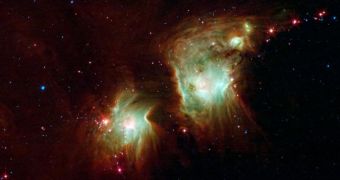Experts with the American space agency announce that the NASA Spitzer Space Telescope has just produced a new set if images depicting a double nebula located relatively close to Earth. The murky area of stellar formation is thus brought back into the spotlight.
From afar, the cosmic structure looks like a pair of weird sunglasses. Though it appears to be made up of two joining components, the colorful clouds that we see in this image are in fact areas that have been carved out from the surrounding gas and dust cloud.
Spitzer can see these holes because it conducts studies in the infrared portion of the electromagnetic spectrum. These wavelengths can easily penetrate gas and dust clouds, wheres radiation in the visible-light spectrum cannot.
When viewed with telescopes such as the Hubble, which only function in visible light, the Messier 78 nebula appears as any other object of its class. But studies conducted with Spitzer reveal the existence of numerous protostars, located just beyond the thick veils.
“The two round greenish nebulae are actually cavities carved out of the surrounding dark dust clouds,” experts at the NASA Jet Propulsion Laboratory (JPL) explains. JPL is managed by the California Institute of Technology, in Pasadena.
Caltech also manages the Spitzer Science Center (SSC), which deals with processing the data the telescope sends back, and with developing new theories based on the information aquired.
“The extended dust is mostly dark, even to Spitzer's view, but the edges show up in mid-wavelength infrared light as glowing, red frames surrounding the bright interiors,” JPL experts add.
“A string of baby stars that have yet to burn their way through their natal shells can be seen as red pinpoints on the outside of the nebula. Eventually these will blossom into their own glowing balls, turning this two-eyed eyeglass into a many-eyed monster of a nebula,” the reveal.
Interestingly, while the nebula appears dull when seen by amateur astronomers, it takes on new dimensions in infrared light, where it reveals its inner glow. Experts say that, soon enough, the dust will clear out to some extent, allowing better views of the nebula.
The three-color composite image that was just released features data collected from the infrared array camera and the multi-band imaging photometer on Spitzer. Together, these information provide one of the clearest views into Messier 78.

 14 DAY TRIAL //
14 DAY TRIAL //